Kid’s Clothing Store Business Plan
Popular culture is no longer regional. The advent of cable television, syndicated radio programs, and the Internet has created a world where a fashion statement in New York will be on the streets in a small midwestern town within days. The speed of our telecommunication system has increased young customers’ expectations and demands for products that represent their own cultural statement.
This clothing store business plan details how SmokeJumpers will offer young customers the youth-oriented products and clothing popular in large urban areas but not locally.
The target customer is “Generation Y,” age 11-18, who listens to alternative music, participates in youth sports like skateboarding and snowboarding, and looks toward alternative clothing trends in large urban areas for inspiration. SmokeJumpers will provide distinctive clothing, shoes, and products just ahead of the fashion curve.
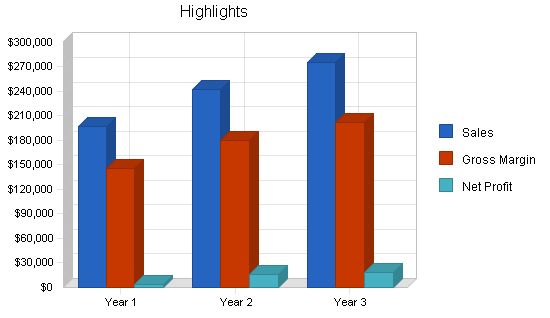
SmokeJumpers aims to provide unique youth-oriented fashion and products to its target customers.
Keys to Success:
– Accessible store offering a constantly updated selection.
– Strong vendor relationships for efficient order shipment.
– Effective advertising strategy targeting our customers.
– Development of an attractive and trendy store image.
SmokeJumpers will offer popular youth-oriented clothing and products not currently available locally. Owner John Stewart will establish a cost-effective operation to swiftly introduce new alternative clothing and products to customers.
Start-up Summary:
SmokeJumpers’ start-up costs include inventory and store displays. The company has secured sufficient investment and a short-term loan.
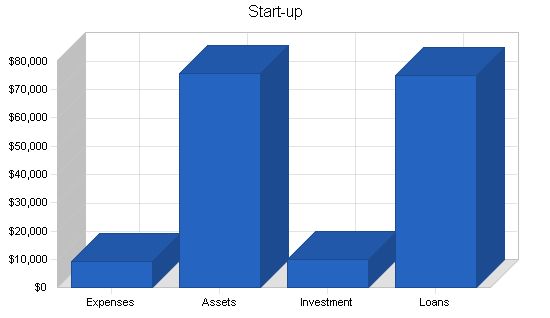
Start-up
Requirements:
– Legal: $1,000
– Stationery etc.: $100
– Store Floor Setup: $5,000
– Insurance: $1,000
– Rent: $2,000
– Other: $0
– Total Start-up Expenses: $9,100
Start-up Assets:
– Cash Required: $40,000
– Start-up Inventory: $30,000
– Other Current Assets: $900
– Long-term Assets: $5,000
– Total Assets: $75,900
Total Requirements: $85,000
Start-up Funding:
– Start-up Expenses to Fund: $9,100
– Start-up Assets to Fund: $75,900
– Total Funding Required: $85,000
Assets:
– Non-cash Assets from Start-up: $35,900
– Cash Requirements from Start-up: $40,000
– Additional Cash Raised: $0
– Cash Balance on Starting Date: $40,000
– Total Assets: $75,900
Liabilities and Capital:
– Liabilities:
– Current Borrowing: $0
– Long-term Liabilities: $50,000
– Accounts Payable (Outstanding Bills): $25,000
– Other Current Liabilities (interest-free): $0
– Total Liabilities: $75,000
– Capital:
– Planned Investment:
– John Steward: $10,000
– Other: $0
– Additional Investment Requirement: $0
– Total Planned Investment: $10,000
– Loss at Start-up (Start-up Expenses): ($9,100)
– Total Capital: $900
Total Capital and Liabilities: $75,900
Total Funding: $85,000
Company Ownership
John Steward is the owner of SmokeJumpers.
Products
SmokeJumpers will offer young customers the following youth-oriented products and clothing:
– Shoes
– Jackets
– Sweaters
– Shirts
– Pants
– Bags
– Hats
– T-shirts
– Dresses and skirts
– Shorts
Market Analysis Summary
According to the U.S. Census Bureau, the population of teens (age 12-17) in 1999 was 23.4 million, representing 8.6% of the total U.S. population. Teens influence $324 billion in spending annually, have $151 billion in disposable income, spend $24 billion annually, and will spend $1.2 billion online by 2002. Teens spend an average of $82 per week on entertainment, fashion, food, and technology. These young people, dubbed "Generation Y," dominate almost all facets of popular culture and are the fastest-growing demographic under age 65.
Specialty youth clothes and products is a billion-dollar niche in the clothing industry. Over the past ten years, there has been a profound change in population dynamics in the U.S. The non-metropolitan population has been growing at almost the same rate as the urban population. Evansville’s current population is 150,000 residents. The city is 250 miles from the closest urban center. Consequently, Evansville’s young people don’t live near a large urban center that offers the diversity in clothing products that the youth culture demands. This has created a small market niche for businesses to sell clothing and products, particularly in communities with a major college located in the community, like Evansville.
Currently, only two regional malls offer access to the fashion and styles that young people want. Unfortunately, the focus of these mall stores is only on the mainstream of the youth market. Alternative clothing and products are rarely available outside urban areas. This is true because the companies that create the clothing and products are small and sell primarily through urban specialty shops.
It is SmokeJumpers’ plan to bring these new alternative fashion and products to its target customer groups.
Market Segmentation
SmokeJumpers will capitalize on the following characteristics of Generation Y:
– Subculture Affiliation: Though rebellious, teens also want to blend in and be accepted by peers. They seek a community of peers to welcome them, as well as help them stand out.
– Attitude: Teenagers wear attitude like a uniform to give definition to their identity. This extends to clothing, hairstyle, and the type of music listened to in public. They also react to humor, silliness, and irreverence more easily than to other styles.
SmokeJumpers will focus on three significant customer groups:
– Skateboarders: This group is a pivotal customer group for SmokeJumpers. Skateboarders are deeply influenced by urban culture, especially in music, footwear, and clothing. Distinctive urban style is an important component of the skateboard culture.
– Alternateens: This group is important for the sustained growth of the business. They represent a wide range of young people who identify themselves as part of the alternative culture. The most critical members of this group for SmokeJumpers are the "weekend warriors" who dress the part only for parties and concerts. They represent the majority of the group and have the most money to spend on products.
– College Students: Evansville University has an enrollment of 12,000 students, of which 5,000 are 19 years of age or younger. In many ways, it is the college population that sustains the alternative culture in Evansville. SmokeJumpers will advertise in the student daily newspaper to bring this target customer group into the store.
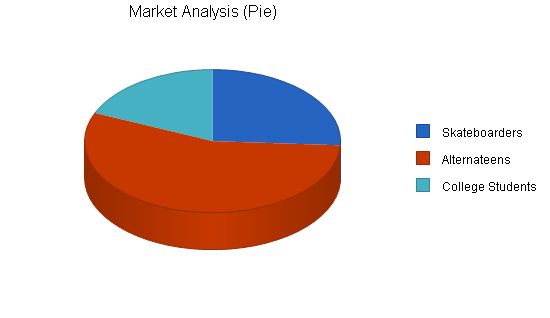
Market Analysis
Potential Customers Growth Year 1 Year 2 Year 3 Year 4 Year 5 CAGR
Skateboarders 15% 7,000 8,050 9,258 10,647 12,244 15.00%
Alternateens 17% 15,000 17,550 20,534 24,025 28,109 17.00%
College Students 10% 5,000 5,500 6,050 6,655 7,321 10.00%
Total 15.27% 27,000 31,100 35,842 41,327 47,674 15.27%
Strategy and Implementation Summary
SmokeJumpers will focus on becoming the coolest place in Evansville to shop for alternative clothes, shoes, and youth-oriented products.
Competitive Edge
SmokeJumpers’ competitive advantage is offering product lines that make a statement but won’t leave you broke. The major brands are expensive and not distinctive enough to satisfy the ever-changing taste of our target customers. SmokeJumpers offers products that are just ahead of the curve and so affordable that our customers will return to the store often to check out what’s new.
Another competitive factor is that products for this age group are part of a lifestyle statement. SmokeJumpers is focused on serving the Evansville youth. We want to represent their style and life choices. We believe we will create a loyal customer base that will see SmokeJumpers as part of their lives.
To develop good business strategies, perform a SWOT analysis of your business. It’s easy with our free guide and template. Learn how to perform a SWOT analysis.
Sales Strategy
SmokeJumpers’ strategy will be two-track.
– SmokeJumpers will advertise in the Evansville University daily student newspaper and the free Evansville Weekly, which is focused on SmokeJumpers’ target customer groups.
– SmokeJumpers will also plan three events to raise its visibility with target customers. We will assemble a group of boy and girl skateboarders and sponsor them with the SmokeJumpers logo. The skateboard competition will be followed by a street dance. SmokeJumpers will book a local popular alternative college band to play the event. We will find co-sponsors for the events that are also focused on the same target customers. At these events, SmokeJumpers will distribute stickers, caps, t-shirts, and promotional material offering a 20% discount on purchases.
The following is the sales forecast for three years.
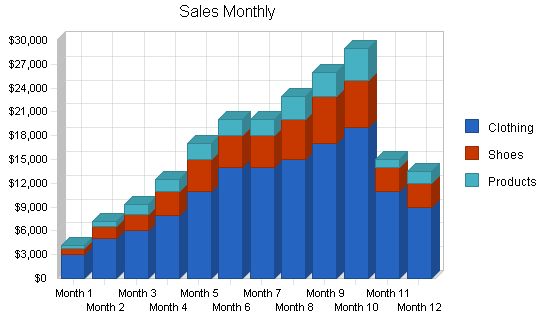
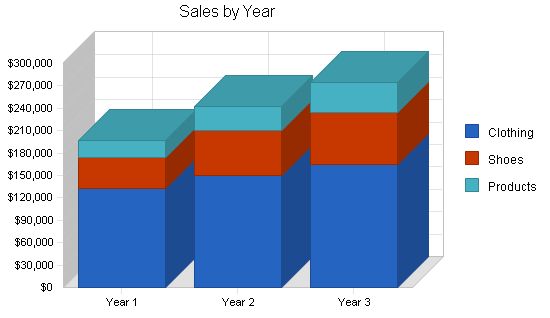
Sales Forecast:
Year 1 Year 2 Year 3
Sales
Clothing $132,000 $150,000 $165,000
Shoes $42,350 $60,000 $70,000
Products $22,300 $32,000 $40,000
Total Sales $196,650 $242,000 $275,000
Direct Cost of Sales:
Year 1 Year 2 Year 3
Clothing $30,300 $36,000 $41,000
Shoes $13,450 $16,000 $19,000
Products $7,360 $10,000 $13,000
Subtotal Direct Cost of Sales $51,110 $62,000 $73,000
Management Summary:
John Steward, owner of SmokeJumpers, will manage the daily operations of the store. With five years of experience in the retail clothing industry, John started as a sales associate with Hoffman Clothing after graduating with a B.A. in English from State University. Within three years, he was promoted to evening manager for the store’s Young Adult Section. John is known for his excellent management skills, especially with younger staff members. He is also a member of the popular alternative band, Infantile Syndrome. These experiences make John uniquely qualified to understand the demands of his target customers.
Personnel Plan:
SmokeJumpers will have a staff of four: a manager (John Steward) and three part-time cashiers/clerks.
Personnel Plan:
Year 1 Year 2 Year 3
Manager $30,000 $34,000 $38,000
Half-time Cashiers/Clerks (3) $24,000 $28,000 $32,000
Total People 4 4 4
Total Payroll $54,000 $62,000 $70,000
The following is the financial plan for SmokeJumpers.
Break-even Analysis:
The monthly break-even point is shown in the table and chart below.
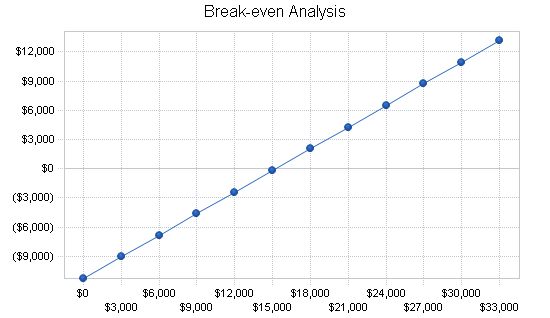
Break-even Analysis
Monthly Revenue Break-even: $15,228
Assumptions:
- Average Percent Variable Cost: 26%
- Estimated Monthly Fixed Cost: $11,270
Projected Profit and Loss
The table and chart below show the projected profit and loss for three years.
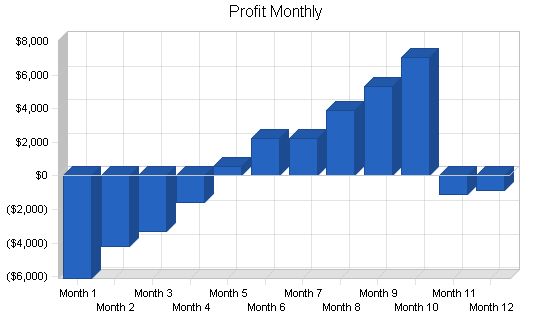
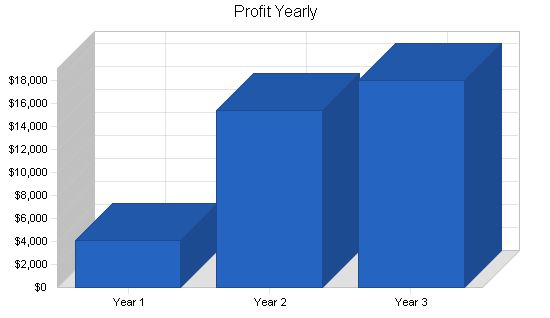
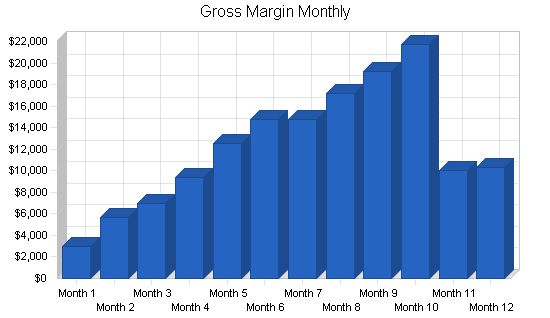

Pro Forma Profit and Loss
Sales
Year 1: $196,650
Year 2: $242,000
Year 3: $275,000
Direct Cost of Sales
Year 1: $51,110
Year 2: $62,000
Year 3: $73,000
Other Production Expenses
Year 1: $0
Year 2: $0
Year 3: $0
Total Cost of Sales
Year 1: $51,110
Year 2: $62,000
Year 3: $73,000
Gross Margin
Year 1: $145,540
Year 2: $180,000
Year 3: $202,000
Gross Margin %
Year 1: 74.01%
Year 2: 74.38%
Year 3: 73.45%
Expenses
Payroll
Year 1: $54,000
Year 2: $62,000
Year 3: $70,000
Sales and Marketing and Other Expenses
Year 1: $30,000
Year 2: $40,000
Year 3: $50,000
Depreciation
Year 1: $7,140
Year 2: $7,140
Year 3: $7,140
Leased Equipment
Year 1: $0
Year 2: $0
Year 3: $0
Utilities
Year 1: $6,000
Year 2: $6,000
Year 3: $6,000
Insurance
Year 1: $6,000
Year 2: $6,000
Year 3: $6,000
Rent
Year 1: $24,000
Year 2: $24,000
Year 3: $24,000
Payroll Taxes
Year 1: $8,100
Year 2: $9,300
Year 3: $10,500
Other
Year 1: $0
Year 2: $0
Year 3: $0
Total Operating Expenses
Year 1: $135,240
Year 2: $154,440
Year 3: $173,640
Profit Before Interest and Taxes
Year 1: $10,300
Year 2: $25,560
Year 3: $28,360
EBITDA
Year 1: $17,440
Year 2: $32,700
Year 3: $35,500
Interest Expense
Year 1: $4,480
Year 2: $3,560
Year 3: $2,600
Taxes Incurred
Year 1: $1,746
Year 2: $6,600
Year 3: $7,728
Net Profit
Year 1: $4,074
Year 2: $15,400
Year 3: $18,032
Net Profit/Sales
Year 1: 2.07%
Year 2: 6.36%
Year 3: 6.56%
Projected Cash Flow
The following table and chart presents the projected cash flow for three years.
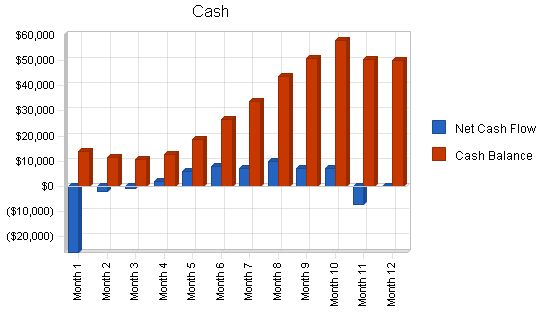
Pro Forma Cash Flow
| Year 1 | Year 2 | Year 3 | |
| Cash Received | |||
| Cash from Operations | |||
| Cash Sales | $196,650 | $242,000 | $275,000 |
| Subtotal Cash from Operations | $196,650 | $242,000 | $275,000 |
| Additional Cash Received | |||
| Sales Tax, VAT, HST/GST Received | $0 | $0 | $0 |
| New Current Borrowing | $0 | $0 | $0 |
| New Other Liabilities (interest-free) | $0 | $0 | $0 |
| New Long-term Liabilities | $0 | $0 | $0 |
| Sales of Other Current Assets | $0 | $0 | $0 |
| Sales of Long-term Assets | $0 | $0 | $0 |
| New Investment Received | $0 | $0 | $0 |
| Subtotal Cash Received | $196,650 | $242,000 | $275,000 |
| Expenditures | |||
| Expenditures from Operations | |||
| Cash Spending | $54,000 | $62,000 | $70,000 |
| Bill Payments | $122,893 | $167,509 | $182,158 |
| Subtotal Spent on Operations | $176,893 | $229,509 | $252,158 |
| Additional Cash Spent | |||
| Sales Tax, VAT, HST/GST Paid Out | $0 | $0 | $0 |
| Principal Repayment of Current Borrowing | $0 | $0 | $0 |
| Other Liabilities Principal Repayment | $0 | $0 | $0 |
| Long-term Liabilities Principal Repayment | $9,600 | $9,600 | $9,600 |
| Purchase Other Current Assets | $0 | $0 | $0 |
| Purchase Long-term Assets | $0 | $0 | $0 |
| Dividends | $0 | $0 | $0 |
| Subtotal Cash Spent | $186,493 | $239,109 | $261,758 |
| Net Cash Flow | $10,157 | $2,891 | $13,242 |
| Cash Balance | $50,157 | $53,048 | $66,290 |
Projected Balance Sheet
The following table displays the projected balance sheet for three years.
| Year 1 | Year 2 | Year 3 | |
| Assets | |||
| Current Assets | |||
| Cash | $50,157 | $53,048 | $66,290 |
| Inventory | $3,465 | $20,879 | $23,861 |
| Other Current Assets | $900 | $900 | $900 |
| Total Current Assets | $54,522 | $74,827 | $91,051 |
| Long-term Assets | |||
| Long-term Assets | $5,000 | $5,000 | $5,000 |
| Accumulated Depreciation | $7,140 | $14,280 | $21,420 |
| Total Long-term Assets | ($2,140) | ($9,280) | ($16,420) |
| Total Assets | $52,382 | $65,547 | $74,631 |
| Liabilities and Capital | |||
| Current Liabilities | |||
| Accounts Payable | $7,008 | $14,373 | $15,025 |
| Current Borrowing | $0 | $0 | $0 |
| Other Current Liabilities | $0 | $0 | $0 |
| Subtotal Current Liabilities | $7,008 | $14,373 | $15,025 |
| Long-term Liabilities | $40,400 | $30,800 | $21,200 |
| Total Liabilities | $47,408 | $45,173 | $36,225 |
| Paid-in Capital | $10,000 | $10,000 | $10,000 |
| Retained Earnings | ($9,100) | ($5,026) | $10,374 |
| Earnings | $4,074 | $15,400 | $18,032 |
| Total Capital | $4,974 | $20,374 | $38,406 |
| Total Liabilities and Capital | $52,382 | $65,547 | $74,631 |
| Net Worth | $4,974 | $20,374 | $38,406 |
Business ratios for the years of this plan are shown below. Industry profile ratios based on the Standard Industrial Classification (SIC) code 5999, Miscellaneous Retail Stores, are shown for comparison.
| Year 1 | Year 2 | Year 3 | Industry Profile | |
| Sales Growth | n.a. | 23.06% | 13.64% | 6.30% |
| Percent of Total Assets | ||||
| Inventory | 6.61% | 31.85% | 31.97% | 39.30% |
| Other Current Assets | 1.72% | 1.37% | 1.21% | 23.90% |
| Total Current Assets | 104.09% | 114.16% | 122.00% | 80.10% |
| Long-term Assets | -4.09% | -14.16% | -22.00% | 19.90% |
| Total Assets | 100.00% | 100.00% | 100.00% | 100.00% |
| Current Liabilities | ||||
| Accounts Payable | 13.38% | 21.93% | 20.13% | 46.00% |
| Long-term Liabilities | 77.13% | 46.99% | 28.41% | 14.00% |
| Total Liabilities | 90.50% | 68.92% | 48.54% | 60.00% |
| Net Worth | 9.50% | 31.08% | 51.46% | 40.00% |
| Percent of Sales | ||||
| Sales | 100.00% | 100.00% | 100.00% | 100.00% |
| Gross Margin | 74.01% | 74.38% | 73.45% | 34.10% |
| Selling, General & Administrative Expenses | 71.94% | 68.02% | 66.90% | 19.80% |
| Advertising Expenses | 15.26% | 16.53% | 18.18% | 2.60% |
| Profit Before Interest and Taxes | 5.24% | 10.56% | 10.31% | 1.10% |
| Main Ratios | ||||
| Current | 7.78 | 5.21 | 6.06 | 1.77 |
| Quick | 7.29 | 3.75 | 4.47 |
| Pro Forma Cash Flow | |||||||||||||
| Month 1 | Month 2 | Month 3 | Month 4 | Month 5 | Month 6 | Month 7 | Month 8 | Month 9 | Month 10 | Month 11 | Month 12 | ||
| Cash Received | |||||||||||||
| Cash Sales | $4,100 | $7,200 | $9,350 | $12,500 | $17,000 | $20,000 | $20,000 | $23,000 | $26,000 | $29,000 | $15,000 | $13,500 | |
| Subtotal Cash from Operations | $4,100 | $7,200 | $9,350 | $12,500 | $17,000 | $20,000 | $20,000 | $23,000 | $26,000 | $29,000 | $15,000 | $13,500 | |
| Additional Cash Received | |||||||||||||
| Sales Tax, VAT, HST/GST Received | 0.00% | $0 | $0 | $0 | $0 | $0 | $0 | $0 | $0 | $0 | $0 | $0 | $0 |
| New Current Borrowing | $0 | $0 | $0 | $0 | $0 | $0 | $0 | $0 | $0 | $0 | $0 | $0 | $0 |
| New Other Liabilities (interest-free) | $0 | $0 | $0 | $0 | $0 | $0 | $0 | $0 | $0 | $0 | $0 | $0 | $0 |
| New Long-term Liabilities | $0 | $0 | $0 | $0 | $0 | $0 | $0 | $0 | $0 | $0 | $0 | $0 | $0 |
| Sales of Other Current Assets | $0 | $0 | $0 | $0 | $0 | $0 | $0 | $0 | $0 | $0 | $0 | $0 | $0 |
| Sales of Long-term Assets | $0 | $0 | $0 | $0 | $0 | $0 | $0 | $0 | $0 | $0 | $0 | $0 | $0 |
| New Investment Received | $0 | $0 | $0 | $0 | $0 | $0 | $0 | $0 | $0 | $0 | $0 | $0 | $0 |
| Subtotal Cash Received | $4,100 | $7,200 | $9,350 | $12,500 | $17,000 | $20,000 | $20,000 | $23,000 | $26,000 | $29,000 | $15,000 | $13,500 | |
| Expenditures | |||||||||||||
| Expenditures from Operations | |||||||||||||
| Cash Spending | $4,500 | $4,500 | $4,500 | $4,500 | $4,500 | $4,500 | $4,500 | $4,500 | $4,500 | $4,500 | $4,500 | $4,500 | |
| Bill Payments | $25,132 | $3,999 | $4,790 | $5,181 | $5,918 | $6,835 | $7,498 | $7,692 | $13,557 | $16,727 | $17,103 | $8,463 | |
| Subtotal Spent on Operations | $29,632 | $8,499 | $9,290 | $9,681 | $10,418 | $11,335 | $11,998 | $12,192 | $18,057 | $21,227 | $21,603 | $12,963 | |
| Additional Cash Spent | |||||||||||||
| Sales Tax, VAT, HST/GST Paid Out | $0 | $0 | $0 | $0 | $0 | $0 | $0 | $0 | $0 | $0 | $0 | $0 | $0 |
| Principal Repayment of Current Borrowing | $0 | $0 | $0 | $0 | $0 | $0 | $0 | $0 | $0 | $0 | $0 | $0 | $0 |
| Other Liabilities Principal Repayment | $0 | $0 | $0 | $0 | $0 | $0 | $0 | $0 | $0 | $0 | $0 | $0 | $0 |
| Long-term Liabilities Principal Repayment | $800 | $800 | $800 | $800 | $800 | $800 | $800 | $800 | $800 | $800 | $800 | $800 | $800 |
| Purchase Other Current Assets | $0 | $0 | $0 | $0 | $0 | $0 | $0 | $0 | $0 | $0 | $0 | $0 | $0 |
| Purchase Long-term Assets | $0 | $0 | $0 | $0 | $0 | $0 | $0 | $0 | $0 | $0 | $0 | $0 | $0 |
| Dividends | $0 | $0 | $0 | $0 | $0 | $0 | $0 | $0 | $0 | $0 | $0 | $0 | $0 |
| Subtotal Cash Spent | $30,432 | $9,299 | $10,090 | $10,481 | $11,218 | $12,135 | $12,798 | $12,992 | $18,857 | $22,027 | $22,403 | $13,763 | |
| Net Cash Flow | ($26,332) | ($2,099) | ($740) | $2,019 | $5,782 | $7,865 | $7,202 | $10,008 | $7,143 | $6,973 | ($7,403) | ($263) | |
| Cash Balance | $13,668 | $11,569 | $10,829 | $12,848 | $18,630 | $26,495 | $33,697 | $43,706 | $50,849 | $57,822 | $50,420 | $50,157 |
Pro Forma Balance Sheet
| Pro Forma Balance Sheet | |||||||||||||
| Month 1 | Month 2 | Month 3 | Month 4 | Month 5 | Month 6 | Month 7 | Month 8 | Month 9 | Month 10 | Month 11 | Month 12 | ||
| Assets | Starting Balances | ||||||||||||
| Current Assets | |||||||||||||
| Cash | $40,000 | $13,668 | $11,569 | $10,829 | $12,848 | $18,630 | $26,495 | $33,697 | $43,706 | $50,849 | $57,822 | $50,420 | $50,157 |
| Inventory | $30,000 | $28,870 | $27,340 | $24,940 | $21,840 | $17,340 | $12,140 | $6,940 | $6,380 | $7,480 | $8,030 | $5,500 | $3,465 |
| Other Current Assets | $900 | $900 | $900 | $900 | $900 | $900 | $900 | $900 | $900 | $900 | $900 | $900 | $900 |
| Total Current Assets | $70,900 | $43,438 | $39,809 | $36,669 | $35,588 | $36,870 | $39,535 | $41,537 | $50,986 | $59,229 | $66,752 | $56,820 | $54,522 |
| Long-term Assets | |||||||||||||
| Long-term Assets | $5,000 | $5,000 | $5,000 | $5,000 | $5,000 | $5,000 | $5,000 | $5,000 | $5,000 | $5,000 | $5,000 | $5,000 | $5,000 |
| Accumulated Depreciation | $0 | $595 | $1,190 | $1,785 | $2,380 | $2,975 | $3,570 | $4,165 | $4,760 | $5,355 | $5,950 | $6,545 | $7,140 |
| Total Long-term Assets | $5,000 | $4,405 | $3,810 | $3,215 | $2,620 | $2,025 | $1,430 | $835 | $240 | ($355) | ($950) | ($1,545) | ($2,140) |
| Total Assets | $75,900 | $47,843 | $43,619 | $39,884 | $38,208 | $38,895 | $40,965 | $42,372 | $51,226 | $58,874 | $65,802 | $55, |
Hello!
I’m Andrew Brooks, a seasoned finance consultant from the USA and the mind behind phonenumber247.com.
My career is built on a foundation of helping individuals and businesses thrive financially in an ever-changing economic landscape. At phonenumber247.com, my aim is to demystify the complex world of finance, providing clear, actionable advice that can help you navigate your financial journey with confidence. Whether it’s personal finance management, investment strategies, or understanding the nuances of market dynamics, I’m here to share insights and tools that can propel you towards your financial goals.
Welcome to my digital space, where every piece of advice is a step closer to financial clarity and success!
